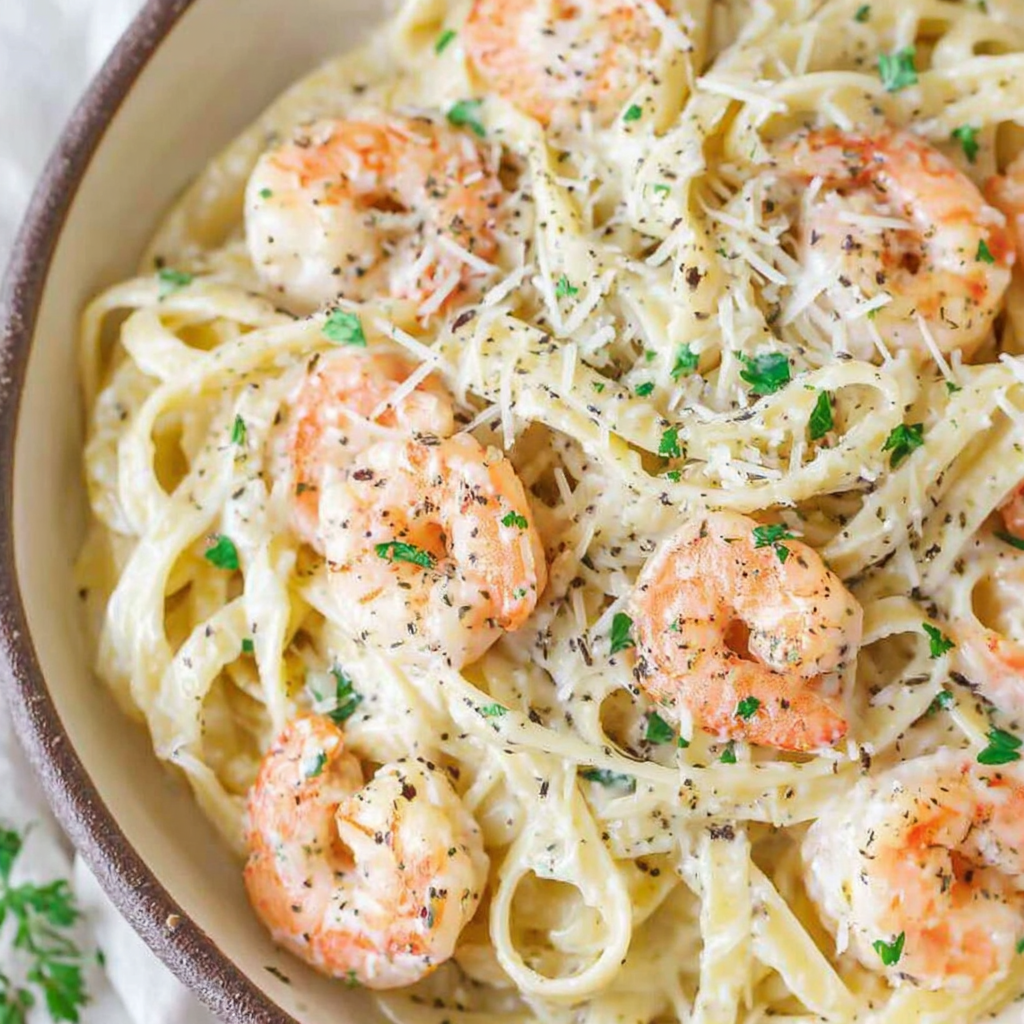Thai Crunch Salad — CPK Copycat with Peanut Ginger Sauce

A vibrant, crunchy copycat of CPK's Thai salad: shredded cabbage, crisp veggies, toasted ramen and a silky peanut-ginger dressing. Perfect for weeknights, potlucks, and make-ahead lunches.
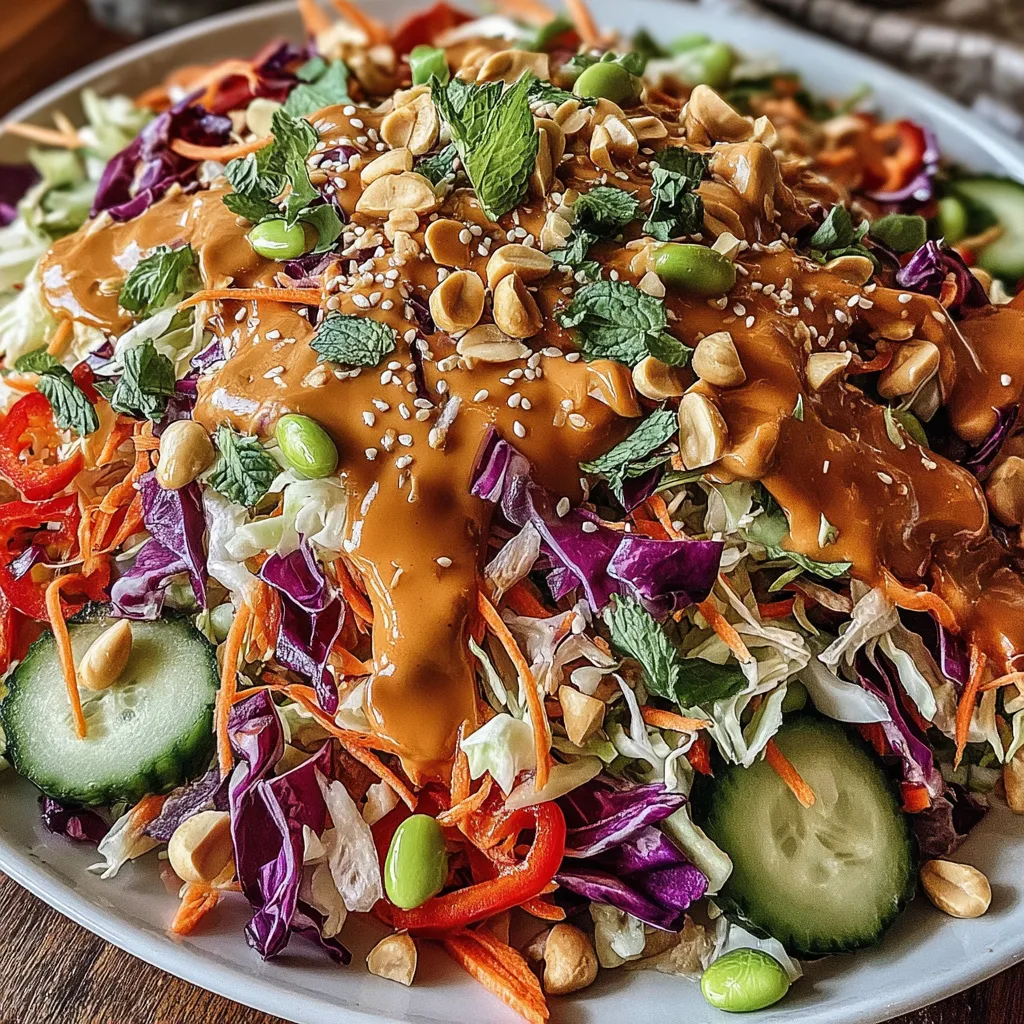
This Thai Crunch Salad is one of those recipes that changed my weeknight routine the moment I discovered it. I first tasted a version of this at a neighborhood gathering and was captivated by the contrast: crunchy vegetables, warm toasted ramen bits, bright herbs and a lusciously creamy peanut-ginger dressing that balanced sweet, salty and spicy with real finesse. I recreated it in my kitchen with pantry-friendly ingredients, and it quickly became a staple for potlucks and weekday dinners. The first time I served it, my partner declared it "restaurant-level," and friends kept asking for the dressing recipe.
What makes this salad special is texture: every bite has a crisp chew from cabbage and red pepper, a little snap from edamame and bean sprouts, and a toasty crunch from broken, fried ramen. The peanut-ginger sauce ties everything together — its natural peanut butter body, bright lime and rice vinegar acidity, and the heat of sriracha create an addictive coating rather than just a tossed dressing. I love how versatile it is: make it with whatever crunchiest veg you have, swap herbs, or scale up for a crowd. It keeps well, travels well, and adds a burst of color to any table.
Why You'll Love This Recipe
- This comes together quickly — about 25 minutes from start to finish — making it a perfect last-minute side or main for weeknights.
- Uses pantry-friendly staples like natural peanut butter and ramen noodles, so you can make it without a special grocery run.
- Make-ahead friendly: the sauce keeps separately for up to 1 week and the toasted ramen can be stored in an airtight jar.
- Crowd-pleasing texture contrast: crisp cabbage and peppers, soft bean sprouts, chewy edamame and crunchy nuts/ramen.
- Flexible for dietary needs — easy to swap tamari for gluten-free soy, or use sunflower seed butter for nut-free versions.
- Bright, fresh herbs (cilantro, Thai basil, mint) add authentic aromatic lift and make each serving taste lively and restaurant-polished.
When I first served this at a summer potluck, people returned for seconds and someone asked if I’d left out a secret ingredient. I didn’t — it was just good technique: shredding the cabbage fine, toasting the ramen until golden, and whisking the sauce until silky smooth. That trio of small details makes a huge difference.
Ingredients
- Cabbage/coleslaw mix: 4 cups shredded cabbage or a pre-packaged coleslaw mix — I prefer a mix that includes both green and purple for color. If buying whole heads, aim for firm, heavy heads with tight leaves.
- Red cabbage or napa: 1 cup shredded red or napa cabbage — adds a bright color and slightly peppery bite; red cabbage holds its color well when dressed.
- Carrots: 1 1/2 cups shredded carrots — look for firm, sweet carrots; a box grater or food processor shredder speeds this up.
- Cucumber: 1 cup large diced cucumber — English cucumber works well because it has fewer seeds and thin skin.
- Red pepper: 1 cup large dice or thin slices — choose a firm, glossy pepper for crunch and sweetness.
- Green onions: 3–4, sliced — the white part adds bite while the green tops bring brightness.
- Edamame: 1 cup, shelled and steamed — buy frozen shelled edamame and steam per package directions; cool before adding.
- Bean sprouts: 1 1/2 cups — for delicate crunch and freshness; rinse before using.
- Serrano pepper: 1 red, finely chopped — adds heat; remove seeds to reduce spice, or substitute jalapeño if preferred.
- Peanut butter (natural): 1/2 cup — choose a smooth, natural-style peanut butter for the creamiest sauce.
- Rice vinegar & lime: 3 tablespoons rice vinegar and 2 tablespoons fresh lime juice — these acids brighten the dressing and cut through the richness.
- Maple syrup: 2 tablespoons — balances the acid and heat with gentle sweetness; honey is a substitute if not strictly vegan.
- Sesame oil: 2 teaspoons (optional) — a little goes a long way for toasty sesame aroma.
- Sriracha or sambal: 2 tablespoons — choose based on preferred heat profile.
- Soy sauce (tamari): 2–3 tablespoons — for salt and umami; use tamari for gluten-free option.
- Fresh ginger & garlic: 1 inch piece ginger (grated) and 1 clove garlic (minced) — fresh aromatics are essential for a vibrant sauce.
- Water: 2–4 tablespoons — used to thin the peanut sauce to the right pouring consistency.
- Herbs: 1 cup chopped cilantro, Thai basil, and/or mint — use a mix for the most aromatic result.
- Toppings: 1/2 cup roasted peanuts and/or sunflower seeds and 1 package ramen noodles, roughly broken and toasted — the toasted ramen is the signature crunch.
Instructions
Prepare the vegetables: Wash and shred all vegetables thoroughly. If using whole heads of cabbage, remove the core and slice thinly, then stack and shred for even ribbons. Dice cucumbers and red peppers into bite-sized pieces to keep each forkful well-balanced. Pat wetter ingredients like cucumber briefly with a paper towel to avoid watering down the dressing. Steam the edamame & rinse sprouts: Steam 1 cup shelled edamame according to package instructions (typically 3–5 minutes). Rinse under cold water to stop cooking and keep bright green. Rinse and drain 1 1/2 cups bean sprouts; they should be crisp and not slimy — discard any that look aged. Toast the ramen: Break one package of dry ramen noodles into large chunks. Heat a dry skillet over medium and toast the pieces, stirring constantly, until golden brown and aromatic (2–4 minutes). Alternatively, heat 1 tablespoon neutral oil and fry briefly for a richer crunch. Drain on paper towels and cool. Make the peanut-ginger sauce: In a mixing bowl, combine 1/2 cup natural peanut butter, 3 tablespoons rice vinegar, 2 tablespoons fresh lime juice, 2 tablespoons maple syrup, 2 teaspoons sesame oil (optional), 2 tablespoons sriracha, 2–3 tablespoons soy sauce (adjust salt), grated 1-inch piece ginger, 1 minced garlic clove and 2–4 tablespoons water. Whisk vigorously until smooth and silky. Adjust water to reach a drizzling consistency — it should cling to vegetables, not pool at the bottom. Toss and assemble: In a large bowl, combine the shredded cabbage, red cabbage, carrots, cucumbers, red pepper, sliced green onions, steamed edamame and bean sprouts. Add chopped herbs and the finely chopped red serrano pepper. Drizzle the peanut-ginger sauce over the salad and toss gently to coat evenly. Taste and adjust seasoning with extra soy or lime if needed. Top with roasted peanuts, sunflower seeds and toasted ramen pieces just before serving so they stay crisp.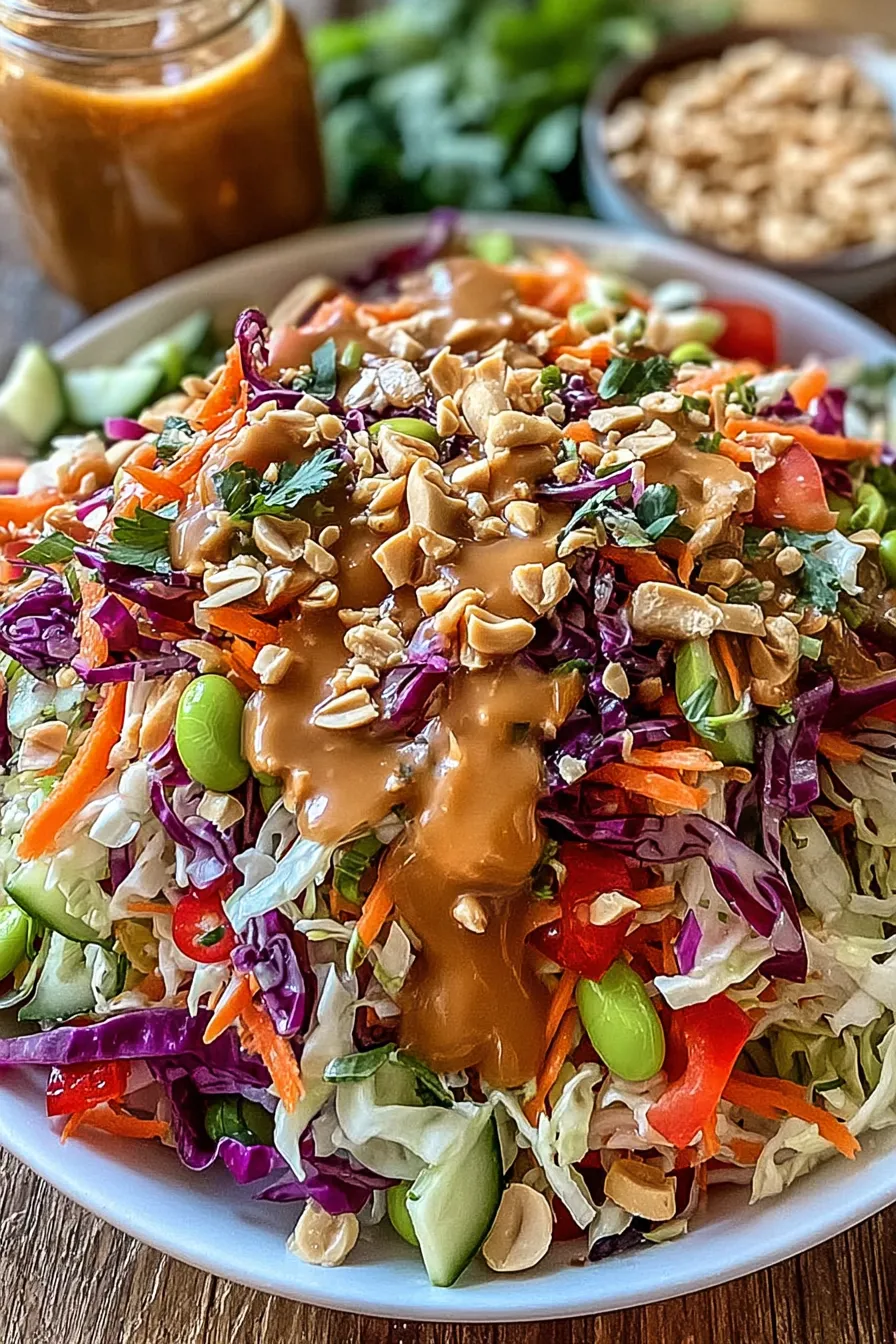
You Must Know
- This salad stores best with the dressing separate — combined, it will soften the cabbage after several hours; keep sauce in an airtight jar for up to 7 days.
- Freezing is not recommended due to the fresh vegetables and crunchy toppings; toasted ramen and nuts can be frozen for longer storage separately.
- High in plant protein thanks to edamame and peanuts, but not gluten-free unless you use gluten-free noodles or omit the ramen.
- Flavor improves if the dressing sits for 30 minutes before tossing, allowing ginger and garlic to mellow into the peanut base.
I love that this dish travels well to picnics: pack the salad and toppings separately, then toss just before serving. The best part of making this at home has been experimenting with herb combinations — sometimes I substitute all Thai basil for cilantro for a peppery lift, other times I use a mint-heavy mix in summer.
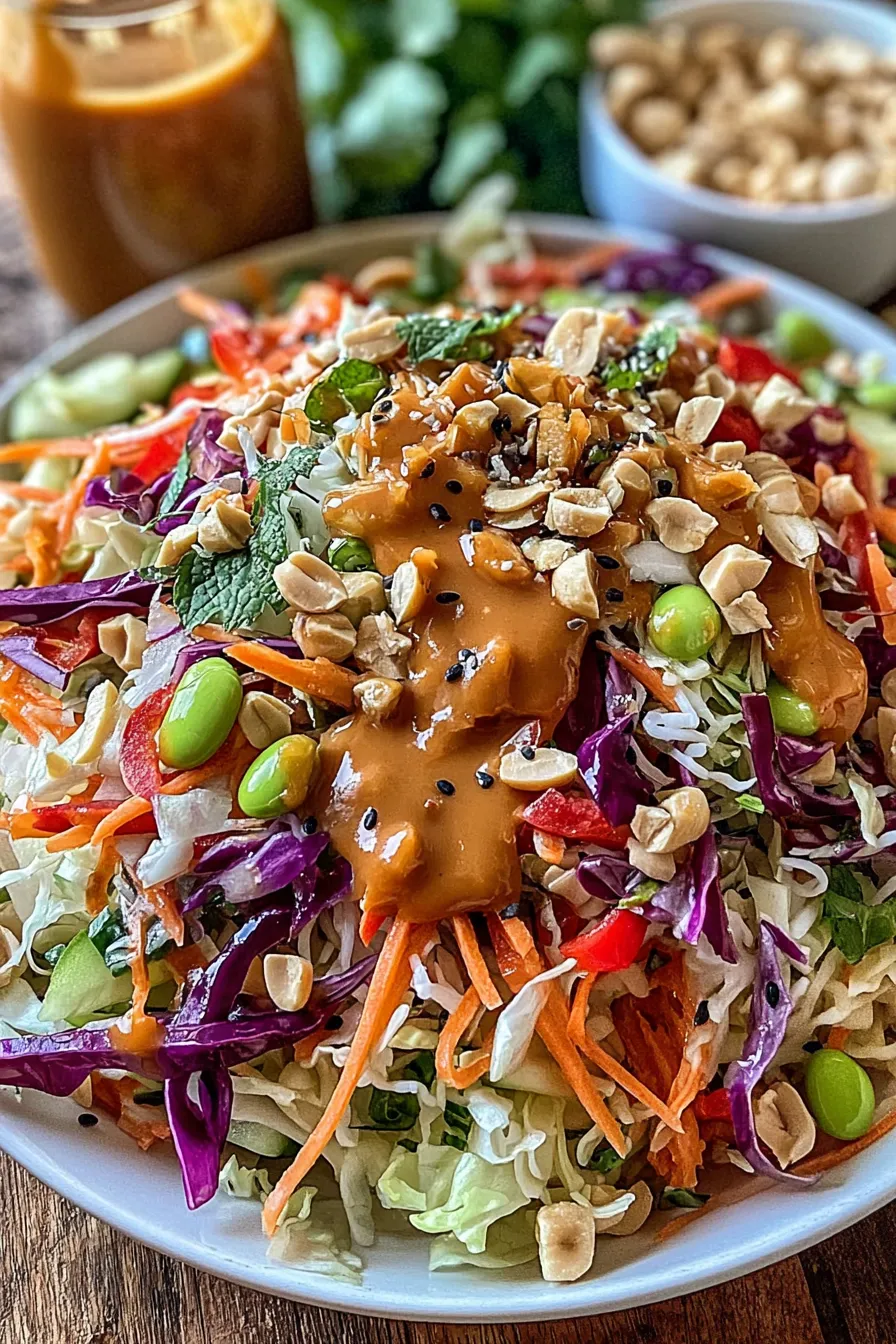
Storage Tips
Store the peanut-ginger sauce in a sealed jar in the refrigerator for up to one week; if it thickens, whisk in a tablespoon of warm water before using. Keep the salad base (shredded cabbage, carrots, peppers, edamame and sprouts) in an airtight container for 2–3 days — add herbs fresh when ready to serve. Pack toppings (toasted ramen, peanuts, sunflower seeds) separately in small bags or a jar and add at serving to preserve crunch. Reheat is unnecessary; serve chilled or at cool room temperature.
Ingredient Substitutions
For a nut-free version, swap peanut butter for an equal amount of sunflower seed butter and use toasted pumpkin seeds instead of peanuts. To make it gluten-free, replace the ramen with crushed rice crackers or toasted gluten-free noodles and use tamari in place of soy sauce. If you prefer less heat, reduce sriracha to 1 tablespoon and omit the serrano. For extra umami, stir in 1 teaspoon toasted sesame oil and 1 teaspoon fish sauce (omit for vegetarian).
Serving Suggestions
Serve this as a vibrant side to grilled chicken, shrimp or tofu skewers, or make it the star for a light lunch by adding shredded rotisserie chicken or baked tofu cubes. Garnish with lime wedges, extra chopped herbs and a drizzle of extra sauce. On a buffet, present the salad in a large platter with toppings in bowls so guests can build their own texture profile. It shines at summer potlucks and pairs beautifully with cold noodles or sticky rice.
Cultural Background
This style of salad borrows from Southeast Asian flavor principles — balancing sour, sweet, salty and spicy — while adapting textures common in Americanized restaurant salads. The peanut-ginger profile has parallels with dishes across Thailand and neighboring countries, where peanuts and fresh herbs are used as accents. The toasted ramen topping is a Californian import popularized by casual restaurants for its playful crunch and affordability.
Seasonal Adaptations
In spring, emphasize fresh peas, young cukes and a larger proportion of herbs; in summer, add ripe mango or papaya for sweetness and aromatic basil. For autumn and winter, swap some raw veg for quick-pickled carrots or roasted sweet potato cubes to add warmth. Adjust the herb mix to seasonal availability — mint and cilantro in summer, more Thai basil when you can find it.
Meal Prep Tips
Make the sauce ahead and keep in the fridge for up to 7 days. Pre-shred cabbage and carrots and store in separate airtight containers with a paper towel to absorb excess moisture for up to 3 days. Toast the ramen and roast peanuts in advance — both keep their crunch when stored in airtight containers for a week. When assembling lunches, pack sauce and crunchy toppings separately and toss within 30 minutes of eating for the best texture.
This salad is all about joyful contrasts: crunchy and silky, bright and savory. It’s a flexible, forgiving dish that invites experimentation and always rewards an extra squeeze of lime and a handful of fresh herbs. Give it a try, and don’t be surprised when it becomes a go-to in your repertoire.
Pro Tips
Toast the ramen in a dry pan until golden for the best crunch; watch closely to avoid burning.
Make the peanut-ginger sauce a day ahead to deepen the flavors; whisk in water before serving if it thickens.
Keep crunchy toppings separate until just before serving to preserve texture.
Use a food processor to shred large quantities of cabbage quickly and evenly.
Adjust the heat by varying sriracha and removing seeds from the serrano pepper if you prefer milder spice.
This nourishing thai crunch salad — cpk copycat with peanut ginger sauce recipe is sure to be a staple in your kitchen. Enjoy every moist, high protein slice — it is perfect for breakfast or as a wholesome snack any time.
Tags
Thai Crunch Salad — CPK Copycat with Peanut Ginger Sauce
This Thai Crunch Salad — CPK Copycat with Peanut Ginger Sauce recipe makes perfectly juicy, tender, and flavorful steak every time! Serve with potatoes and a side salad for an unforgettable dinner in under 30 minutes.

Ingredients
Salad
Sauce
Toppings
Instructions
Prepare the vegetables
Wash and shred all vegetables thoroughly. Remove cores and slice cabbage thinly, shred carrots, dice cucumbers and peppers. Pat wet ingredients like cucumber dry to avoid diluting the dressing.
Steam edamame and rinse bean sprouts
Steam the shelled edamame according to package instructions then cool under cold water. Rinse bean sprouts and drain well to keep them crisp in the salad.
Toast the ramen
Break ramen into large pieces and toast in a dry skillet over medium heat, stirring constantly until golden and aromatic (2–4 minutes). Cool on paper towels; alternatively fry briefly in 1 tablespoon neutral oil for richer flavor.
Make the peanut-ginger sauce
Whisk together peanut butter, rice vinegar, lime juice, maple syrup, sesame oil (optional), sriracha, soy sauce, grated ginger, minced garlic and 2–4 tablespoons water until smooth. Adjust water to reach a pourable consistency.
Assemble and toss
In a large bowl, combine shredded cabbage, red cabbage, carrots, cucumber, red pepper, green onions, edamame and bean sprouts. Add herbs and serrano pepper. Drizzle sauce over the salad and toss gently to coat evenly. Top with roasted peanuts and toasted ramen just before serving.
Last Step: Please leave a rating and comment letting us know how you liked this recipe! This helps our business to thrive and continue providing free, high-quality recipes for you.
Nutrition
Did You Make This?
Leave a comment & rating below or tag
@royalrecipe on social media!

Categories:
You might also like...

Mississippi Mud Brownies
Ultra-fudgy brownies crowned with toasted mini marshmallows and warm cocoa icing, with molten chocolate pockets in every bite.
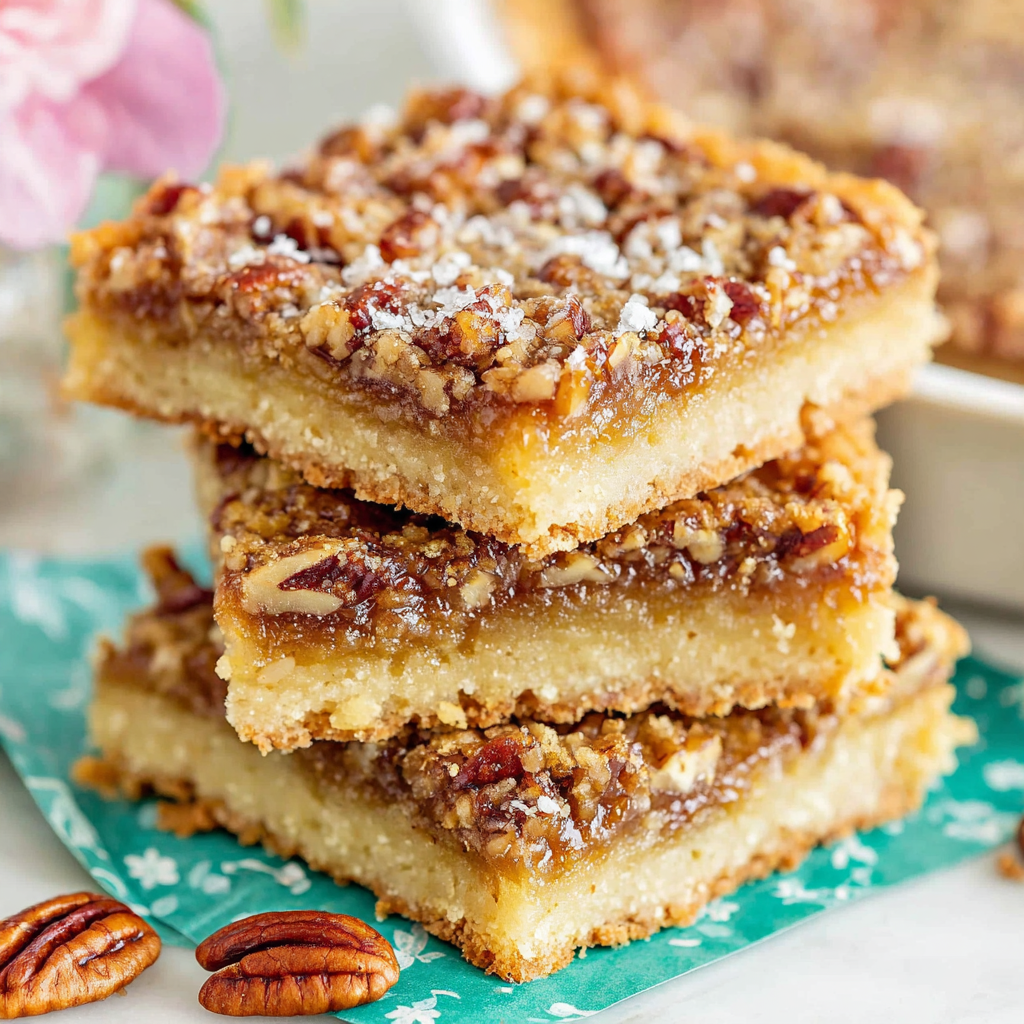
Buttery Pecan Pie Bars
Buttery shortbread crust topped with a gooey brown sugar pecan filling. Just 10 minutes to prep for bakery-worthy bars with irresistible crunch.

Crack-Free Pumpkin Cheesecake
Ultra-creamy pumpkin cheesecake with a graham crust, bakes without cracks, and shines with caramel and rum-kissed whipped cream.

Did You Make This?
Leave a comment & rating below or tag @royalrecipe on social media!
Rate This Recipe
Share This Recipe
Enjoyed this recipe? Share it with friends and family, and don't forget to leave a review!
Comments (1)
This recipe looks amazing! Can't wait to try it.
Comments are stored locally in your browser. Server comments are displayed alongside your local comments.
Hi, I'm Olivia!
What's Popular
30-Minute Meals!
Join to receive our email series which contains a round-up of some of our quick and easy family favorite recipes.

